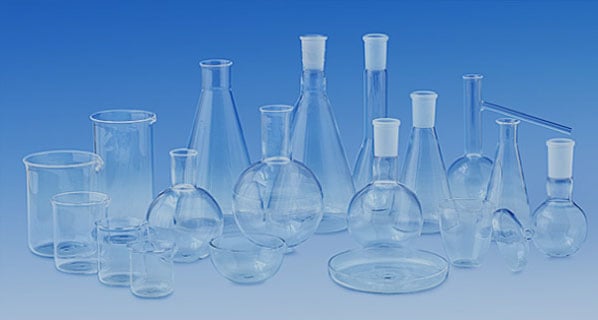At Technical Glass Products, our goal is to supply laboratories with glassware of the highest quality and reliability. Glass may seem like a simple material—but in a lab, the differences between types of glass can dramatically affect performance, safety, durability, chemical compatibility, and cost. This article explains the main types of glass used in lab settings, their advantages and limitations, and guidance on choosing the right type for your application.
What Makes Lab Glass Different
Laboratory glass is engineered to withstand extremes—thermal changes, exposure to chemicals, mechanical stresses, and more. Key performance factors include:
- Thermal shock resistance: ability to endure rapid temperature changes without cracking.
- Chemical resistance: resistance to acids, bases, solvents, water, etc.
- Mechanical strength: ability to withstand pressure, impact, abrasion.
- Optical clarity/transparency: critical for visibility, measurement, and microscopy.
- Cost & manufacturability: some glasses are very costly or difficult to fabricate.
Common Lab-Grade Glass Types
Below are the main categories of glass used in laboratories today, with what makes each unique.
| Type of Glass | Composition & Key Features | Strengths in Lab Use | Limitations / Considerations |
| Borosilicate Glass (e.g. Pyrex-type, Duran) | Silica with boron oxide. Lower coefficient of thermal expansion (~3–5 ×10⁻⁶ /°C). | Very good thermal shock resistance; strong chemical resistance to many acids, alkalis (except strong alkalis at high temperature) and solvents; transparent; widely used for flasks, beakers, condensers, etc. | Can be expensive; not resistant to hydrofluoric acid or strong alkalis at very high temperatures; boron content can leach in some aggressive conditions. |
| Soda-Lime Glass | Primarily silica, soda (sodium oxide), lime (calcium oxide); relatively higher thermal expansion. | Low cost; acceptable for use in simple glassware, low-temperature applications, non-critical visibility; good optical clarity. | Poorer thermal shock resistance; less chemical resistance; can fracture under rapid temperature change; not suitable for high-precision or high-temperature work. |
| Aluminosilicate Glass | Silica with aluminum oxide, sometimes other additives; lower expansion coefficient; stronger than borosilicate in many respects. | Higher mechanical strength; better resistance to certain chemicals; more durable under stress and heat than soda-lime; good when weight, durability or harsh conditions are concerns. | More expensive; less readily available in all shapes/sizes; may have slight optical coloration; fabrication/workability can be more difficult. |
| Quartz / Fused Silica Glass | Nearly pure silicon dioxide; minimal impurities; very high melting point. | Outstanding UV transparency; excellent thermal shock resistance; very low coefficient of thermal expansion; excellent chemical inertness (except for fluorine/hydrofluoric acid); ideal for spectroscopy, optical windows, high-temperature work. | Very expensive; more fragile mechanically (brittle); difficult to fabricate; limited in forms and sizes; more prone to surface damage/scratches. |
| Specialty / Low-Expansion Glasses (e.g. Vycor, borosilicate variants, certain borate or alumino-borosilicate types) | Engineered to combine features: very low thermal expansion, good chemical resistance, optical clarity; often proprietary compositions. | Tailored for extreme environments (high thermal cycling, UV exposure, precision optics, high pressure/temperature); used in laboratories for specialized glass components, instrumentation windows, etc. | Highest cost; limited shape/form options; lead times; may need specific maintenance and handling. |
How to Choose the Right Glass for Your Lab Application
When selecting glassware or components, consider the following decision points:
- Temperature range and thermal cycling
- If you routinely heat, cool, or otherwise subject glassware to rapid temperature shifts, prioritize low expansion and high thermal shock resistance (borosilicate, fused silica).
- Avoid soda-lime in high-heat or rapid temperature change situations.
- Chemical exposure
- Determine what chemicals (including solvents, acids, bases) will contact the glass.
- In highly corrosive acids (like hydrofluoric acid), certain salts, or strong alkali at elevated temperatures, only select types (e.g. fused silica, specialty glasses) will suffice.
- Optical/Physical clarity and precision requirements
- For optical measurements, spectroscopy, microscopy: optical clarity, absence of striae/inclusions, low UV absorption are important; fused silica or high-grade quartz might be necessary.
- For general mixing, heating, storage: borosilicate often balances performance and cost.
- Mechanical stress & durability
- If glassware must withstand impact, pressure, or handling (e.g. transport, frequent handling), consider stronger types (aluminosilicate, some specialty glasses).
- For fragile components like optical windows, specialized maintenance and handling techniques are required.
- Cost vs performance trade-offs
- High-performance glass will cost more both in material and in fabrication.
- It is often more efficient to choose the minimal glass type that meets your safety and performance requirements rather than “premium” by default.
Examples: Matching Glass Type to Use-Case
| Lab Scenario | Glass Type Recommendation |
| Reflux condensers, general heating, autoclavable flasks | Borosilicate glass – excellent thermal and chemical resilience in most standard lab applications. |
| Optics, UV spectroscopy cells, windows in high-temperature reactors | Fused silica or high-purity quartz – optimal transmission and stability at extreme conditions. |
| Water collection, general storage, non-critical labware | Soda-lime glass – cost-effective for lower demands. |
| Pilot plant reactors, pressurized glass assemblies, rugged use | Aluminosilicate or specialty low-expansion glasses – for enhanced strength and reduced risk of failure. |
Care & Handling Tips (to Preserve Glass Performance)
- Preheat or cool gradually when dealing with high or low temperatures; avoid sudden temperature shocks.
- Use compatible sealing, clamp‐holding, and mounting accessories to avoid point stresses.
- Avoid scratching or etching surfaces; even small scratches can become sites of failure.
- Clean using non‐abrasive cleaners, avoid residues; make sure no hidden residues remain exposed to harsh chemicals.
- Inspect regularly for hairline cracks, clouding, or damage; retire any glassware that shows signs of failure risk.
Why Technical Glass Products?
At Technical Glass Products, we manufacture and supply lab glassware designed for performance, safety, and longevity. Our expertise in selecting the correct glass type for each application ensures that customers receive products that:
- Meet the thermal, chemical, optical and mechanical demands of their specific processes;
- Are fabricated to high quality standards with attention to material purity, geometry, finishing, and durability;
- Offer optimal cost‐efficiency by matching the glass to the use case—not over-specifying or underperforming.
Conclusion
Understanding the differences among borosilicate, soda-lime, aluminosilicate, fused silica, and specialty low-expansion glasses is essential when selecting lab glassware. The right choice enhances safety, improves experimental reliability, prolongs service life, and can reduce long-term cost.
If you’re evaluating new lab equipment, considering upgrades, or facing challenging conditions — temperature extremes, aggressive chemicals, precision optical demands — reach out to Technical Glass Products. Let us help you find the perfect glass solution tailored to your lab’s needs.







